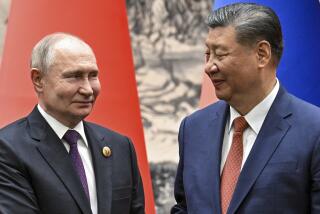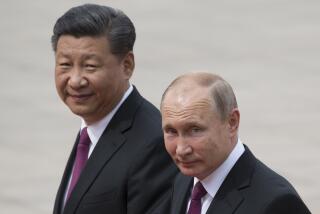30 Years Later, U.S. and China Have Narrowed ‘Gulf’
BEIJING — On the first day of his historic visit here in 1972, President Nixon proposed that China and the United States end their enmity and start a “long march” together. “While we cannot close the gulf between us,” he said, “we can try to bridge it so that we may be able to talk across it.”
Exactly 30 years to the day later, President Bush became the sixth U.S. president to visit the Chinese capital, where he proclaimed Thursday that relations are now “mature, respectful and important” not only to both nations but also to the world.
Yet the president’s words barely described the impact of that 30-year march--or the success of the U.S. policy of engagement.
When Nixon visited Feb. 21, 1972, China was an isolated dictatorship. The government tightly controlled everything from how people dressed--in dreary Mao jackets--to what jobs they could take to the menstrual cycles of women, a senior State Department official recalled recently. And only two hotels put up the few foreigners, mainly other Communists, who were granted visas to China.
U.S. Impact Evident
When Bush arrived Thursday, the “gulf” had been narrowed to the point that the state-run China Daily reported on a new subdivision called Orange County that blends U.S. and Chinese architecture.
Today, about 80% of officials at the vice ministerial level have spent at least six months abroad, most of it in the United States. A pink Baskin-Robbins sign in Chinese is just one of dozens of familiar American logos on Beijing streets. The gleaming towers of Marriott, Sheraton, Hilton and other Western hotels cater to the tens of thousands of businesspeople and tourists who visit here annually. And the Chinese have some freedoms, from what they wear to the election of village representatives.
“This is a very different kind of relationship, which has moved from a state of open animosity and direct or indirect conflict in Korea and Vietnam to a point where we share common views about strategic threats like terrorism,” said Bates Gill, a senior fellow at the Brookings Institution in Washington. “The change is really remarkable.”
Chinese President Jiang Zemin summed up the change at a news conference with Bush on Thursday. “China and the United States now have more rather than less shared interests,” he said.
Not even mentioned here was the forced landing in China of an EP-3 spy plane last April, in which the U.S. crew was held on Hainan island for 11 days before being allowed to leave. Nor did either side make an issue of the fact that they haven’t yet sorted out the disputed costs of that crisis.
“Our ability to bounce back so quickly shows how far we’ve both come,” said a Bush administration specialist in China, who asked to remain anonymous. “It hasn’t affected the core relationship.”
Much is still deeply contentious between the world’s most powerful democracy and the world’s most powerful Communist state. Nixon’s words still have a haunting truth, U.S. analysts caution.
Bush has failed to win a key agreement on curbing weapons proliferation, the top priority in talks with Chinese leaders and a basic tenet of his foreign policy. And serious disagreements remain over Taiwan, human rights, religious freedom, missile defense and possible military action against Iraq. Commerce rather than a common vision has marked the relationship during the past decade, since the Soviet Union’s demise removed the original reason for cooperation.
“Economic interests are the driving force in Sino-U.S. relations and a vital element that both sides have to take into consideration when handling bilateral issues,” Zhu Shida of the Chinese Academy of Social Sciences said in the China Daily on Thursday.
Yet what started out as an uneasy marriage of political convenience between the two nations has been transformed into a relationship that includes $100 billion in annual trade, intelligence-sharing on terrorist threats and cooperation in defusing regional tensions, most recently between India and Pakistan.
“A candid, constructive and cooperative relationship is what we are building with China--candid where we disagree, constructive where we can see some daylight, and cooperative where we have common regional or global interests,” Secretary of State Colin L. Powell said in Senate testimony this month.
Analysts Praise Policy
U.S. analysts both inside and outside government credit American foreign policy under both Republicans and Democrats--and the strategic decision to engage China rather than confront it--for much of China’s transformation. Several rank Washington’s China policy as one of its most successful strategies of recent decades.
The United States has been “fundamentally important in fostering China’s steady reform and opening process,” Gill said. Washington has also played a pivotal role in helping integrate China into major international organizations--on the condition that Beijing accept the international rules and standards of each body.
And it has nudged, prodded and pushed China into reversing course on proliferation of the world’s deadliest weapons. Beijing once advocated nuclear weapons for developing nations as a way of breaking the “hegemonic nuclear monopoly” of the superpowers, Gill said. “But today it understands that nuclear proliferation is not a good thing.”
The one irony, both U.S. and Chinese analysts noted, is that the anniversary of the Nixon visit launching the policy of engagement was marked just as the United States appears to be backing away from engagement as a means to encourage change elsewhere in the world. The Bush administration has instead declared its intent to confront Iraq, Iran and North Korea--labeled by the president an “axis of evil”--and other “evildoers.”
More to Read
Sign up for Essential California
The most important California stories and recommendations in your inbox every morning.
You may occasionally receive promotional content from the Los Angeles Times.










